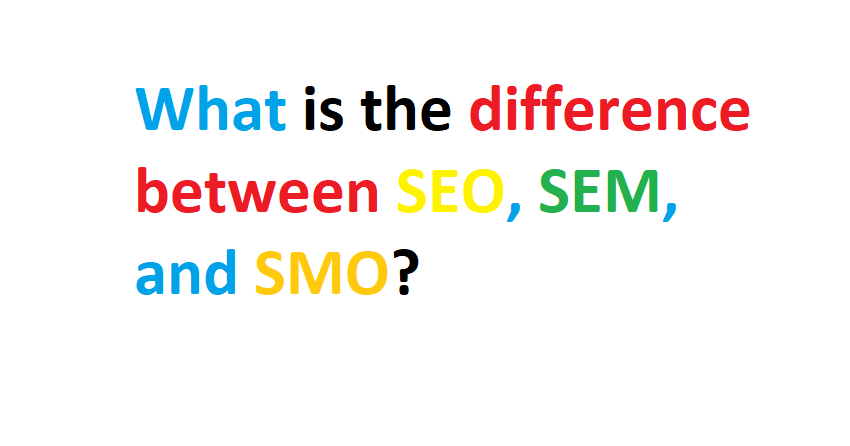What is the difference between SEO, SEM and SMO?

In the realm of digital marketing, there are three commonly used terms: SEO, SEM, and SMO. While they may sound similar, each term represents a distinct approach to improving online visibility and driving traffic to websites. In this article, we will delve into the differences between SEO, SEM, and SMO, helping you understand their unique features and how they contribute to overall digital marketing strategies.
Understanding SEO (Search Engine Optimization)
SEO, or Search Engine Optimization, refers to the practice of optimizing a website to improve its visibility and organic search rankings on search engine result pages (SERPs). It involves various techniques, such as keyword research, on-page optimization, link building, and technical optimizations. The primary goal of SEO is to attract organic traffic from search engines by ensuring that a website appears prominently for relevant search queries.
Exploring SEM (Search Engine Marketing)
SEM, or Search Engine Marketing, encompasses paid advertising efforts to promote a website and increase its visibility on search engine result pages. While SEO focuses on organic traffic, SEM involves paid advertising campaigns through platforms like Google Ads, Bing Ads, and other search engine advertising networks. SEM typically includes pay-per-click (PPC) ads, display advertising, and remarketing campaigns.
Delving into SMO (Social Media Optimization)
SMO, or Social Media Optimization, revolves around harnessing the power of social media platforms to enhance brand visibility, engage with the target audience, and drive traffic to a website. SMO involves optimizing social media profiles, creating shareable content, encouraging user engagement, and leveraging social media advertising. The primary objective of SMO is to establish a strong social media presence and build brand loyalty.
Key Differences Between SEO, SEM, and SMO
Goals and Objectives
The goals of SEO, SEM, and SMO differ in their focus. SEO aims to improve organic search rankings and increase website visibility to attract organic traffic. SEM focuses on driving targeted traffic through paid advertising campaigns. SMO, on the other hand, aims to maximize brand visibility and engagement on social media platforms.
Focus and Channels
SEO primarily focuses on optimizing websites for search engines like Google, Bing, and Yahoo. It involves on-page optimization, technical SEO, and building high-quality backlinks. SEM focuses on paid search campaigns and utilizes search engines as advertising platforms. SMO, as the name suggests, centers around social media platforms such as Facebook, Twitter, Instagram, and LinkedIn.
Traffic Generation
SEO primarily generates organic traffic through improved search engine rankings. SEM generates traffic through paid advertising campaigns, where advertisers pay for clicks or impressions. SMO generates traffic by leveraging the reach and engagement potential of social media platforms.
Cost and ROI
SEO can require upfront investment in terms of time, effort, and resources, but the traffic generated from organic rankings is free. SEM involves direct costs, as advertisers pay for each click or impression in their paid campaigns. SMO can have varying costs, including content creation, social media advertising, and influencer partnerships.
Integration and Synergy
While SEO, SEM, and SMO are distinct approaches, they can work together to enhance overall digital marketing efforts. A well-rounded digital marketing strategy may include a combination of SEO techniques to improve organic visibility, SEM campaigns for targeted advertising, and SMO to amplify brand presence and engagement on social media.
Conclusion
In summary, SEO, SEM, and SMO are integral components of digital marketing, each with its own focus and objectives. SEO targets organic search rankings and visibility, SEM utilizes paid advertising on search engines, and SMO leverages social media platforms to maximize brand presence. Understanding the differences between these approaches is essential for developing an effective digital marketing strategy that aligns with your business goals and target audience.
FAQs
Can I solely rely on SEO for driving website traffic?
While SEO is essential for organic visibility, it may take time to see significant results. It is recommended to complement SEO efforts with other marketing strategies, such as SEM and SMO, to diversify your traffic sources and maximize overall visibility.
How do SEM and SEO complement each other?
SEM and SEO can work together synergistically. SEO provides long-term organic visibility, while SEM offers immediate visibility through paid ads. By combining both approaches, you can achieve a more comprehensive and effective digital marketing strategy.
Is SMO limited to social media platforms?
While SMO primarily focuses on social media platforms, it can extend beyond them. SMO also encompasses optimizing content for social sharing on websites, blogs, and other online platforms to amplify brand reach and engagement.
Which approach should I prioritize: SEO, SEM, or SMO?
The prioritization of SEO, SEM, or SMO depends on your specific business goals, target audience, and available resources. It’s often beneficial to employ a holistic approach that integrates all three strategies to maximize your digital marketing efforts.
How can I measure the effectiveness of my SEO, SEM, and SMO efforts?
Various metrics can be used to measure the effectiveness of SEO, SEM, and SMO efforts. These include organic search rankings, website traffic, click-through rates, conversion rates, social media engagement, and ROI from paid advertising campaigns. Regular monitoring and analysis of these metrics will help you assess the impact of your digital marketing strategies.
Related Articles
Free USA Business Listing Sites List 2023
Guest Posting Sites List 2023, Updated
Free Profile Creation Sites List 2023
Dofollow Social Bookmarking Sites 2023




Thank you for your sharing. I am worried that I lack creative ideas. It is your article that makes me full of hope. Thank you. But, I have a question, can you help me?
I don’t think the title of your article matches the content lol. Just kidding, mainly because I had some doubts after reading the article.